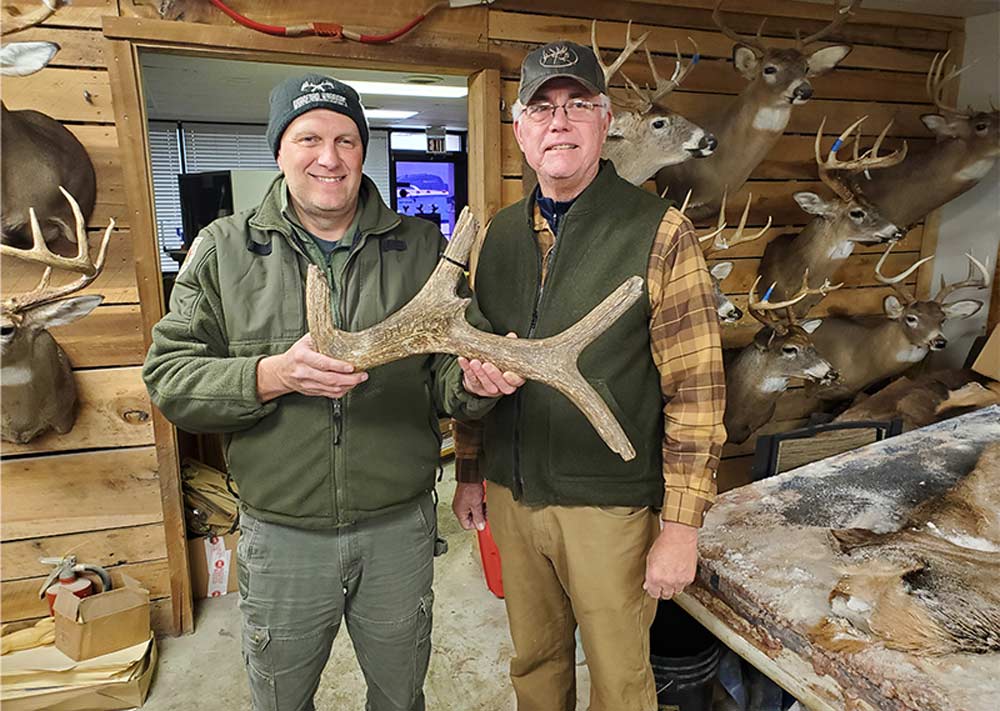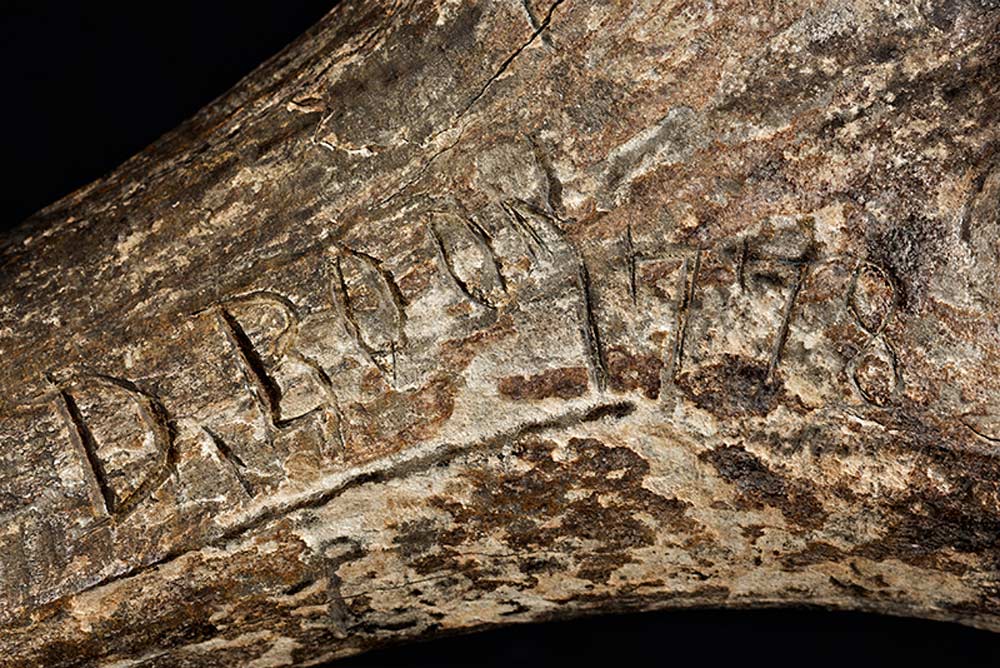The article below appeared in the 2020 May-June issue of Bugle magazine. If not a member of the Rocky Mountain Elk Foundation and you would like to receive more Bugle content like this, go here to join. In the photo below, Joe Lacefield of the Kentucky Department of Fish and Wildlife is holding the antler. RMEF member George Chalfant is on the right.
In 2019, RMEF received a unique request to pay for the carbon-14 dating of an elk antler. The appeal came from the nonprofit Fort Boonesborough Foundation, devoted to sharing the history of Fort Boonesborough State Park southeast of Lexington, Kentucky.
But this wasn’t just any old antler—it has the name “D. BOON” etched into its surface, along with the year 1778. For more than a century it had been an heirloom of a Lexington family. Legend has it great-grandfather James Fisher found the antler as a teenager in the mid-1880s while wandering Hinkston Creek northeast of Lexington.
The family passed it down from generation to generation, showing it to scores of schoolchildren. There is perhaps an ever-so-faint “E” after BOON, but some other artifacts thought to possibly be signed by the famed frontiersman lack that letter at the end of his name. Those include a carved chunk of wood preserved in the museum of the Filson Historical Society in Louisville that reads “D. Boon Kilt a Bar, 1803.”
In 2017, the Fisher family donated the antler to the Fort Boonesborough Foundation with hopes it might become an educational exhibit.
 “One of the family invited my wife and I over saying she had a ‘horn’ she’d like to give us. I thought it was going to be a powder horn,” says former Boonesborough Foundation president and longtime RMEF member George Chalfant. “But then she came out of her storage room with something in a plastic bag that was definitely not a powder horn. And my eyes got really big after I saw the inscription.”
“One of the family invited my wife and I over saying she had a ‘horn’ she’d like to give us. I thought it was going to be a powder horn,” says former Boonesborough Foundation president and longtime RMEF member George Chalfant. “But then she came out of her storage room with something in a plastic bag that was definitely not a powder horn. And my eyes got really big after I saw the inscription.”
So what of the carbon-dating results? Tests date the antler to sometime between 1734 and 1806. That would mean it belonged to the now-extinct Eastern subspecies of elk—and that Boone could indeed have signed it. He lived from 1734 to 1820 and was famous for his exploration of Kentucky and his hunting forays there. Boone founded one of the first English-speaking settlements west of the Appalachian Mountains. Initially called “Boone’s Station,” it’s now known as Boonesborough.
It’s not clear if the antler was a shed or was sawed off a harvested elk. Joe Lacefield, wildlife biologist with the Kentucky Department of Fish and Wildlife Resources, determined the antler is missing 12 to 15 inches of the main beam that would have included both brow tines.
Lacefield has a history of his own with elk in Kentucky. An early RMEF life member, he was on the first crew that assisted with the restoration of elk to the state starting in 1997. RMEF provided advocacy, key funding and volunteer labor to help return wild, free-ranging elk to their native Kentucky that year. RMEF has since funded 187 conservation and hunting heritage outreach projects in the Bluegrass State. Today it’s home to by far the largest population of wild elk east of the Rockies.
Boone hunted elk and deer in Kentucky in the 1760s, ranging along the Tug Fork and Big Sandy rivers with his brother Squire.
Whether the carved signature is authentic will likely forever remain the subject of speculation. But having almost certainly come from one of Kentucky’s native elk, the antler itself is a historic artifact even without the inscription.
The Fort Boonesborough Foundation plans to include it in a permanent exhibit at the reconstructed historic fort.
“We’ve had a ton of interest, and we’re dying to get this exhibit off and running,” says Chalfant. “We’re making a display case for it with RMEF’s logo, and we’re even publishing a book about it along with details of Daniel Boone’s presence in this area during that period of time, as well as the elk reintroduction.”
He says the display will be open to the public as soon as COVID-19 precautions permit, hopefully this summer.
Go here to listen to a podcast hosted by John Stepp that features author Robert Morgan who talks in-depth about Daniel Boone.
(Photo sources: Joe Lacefield/Kentucky Department of Fish and Wildlife & George Chalfant)
